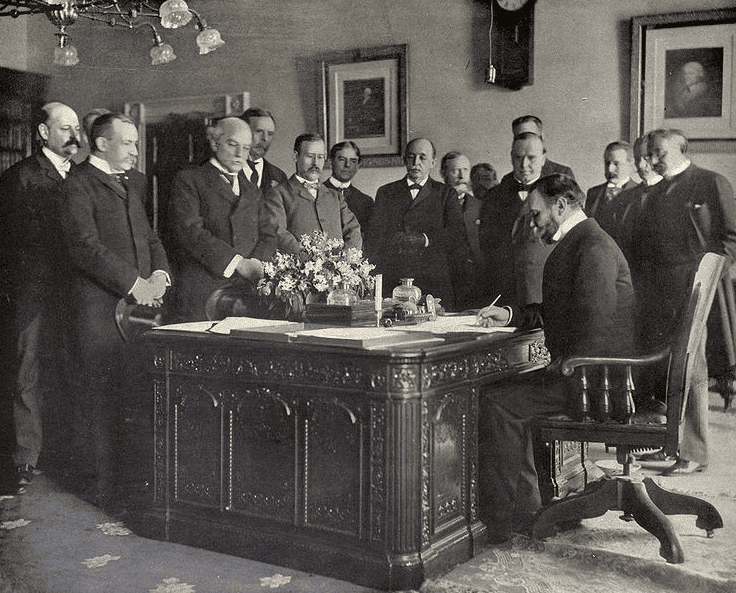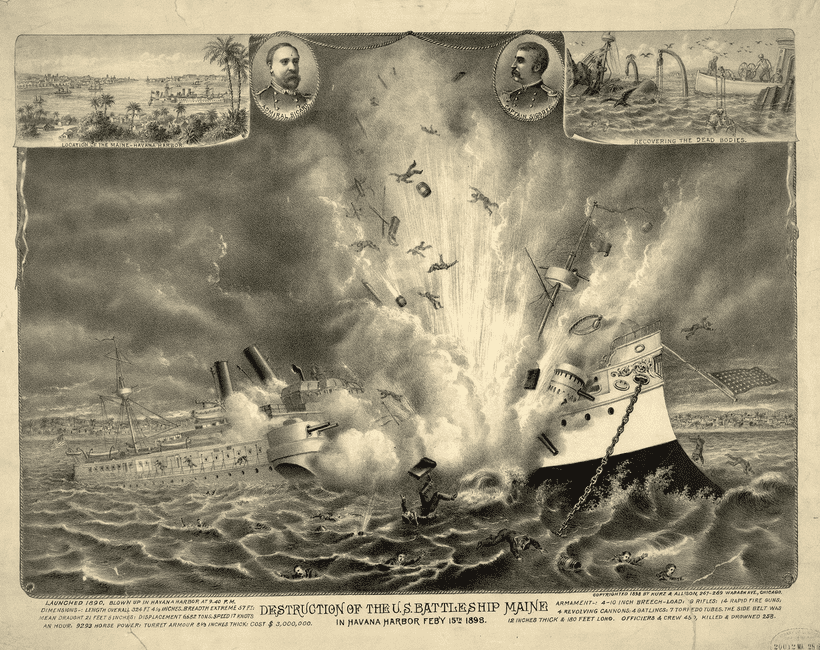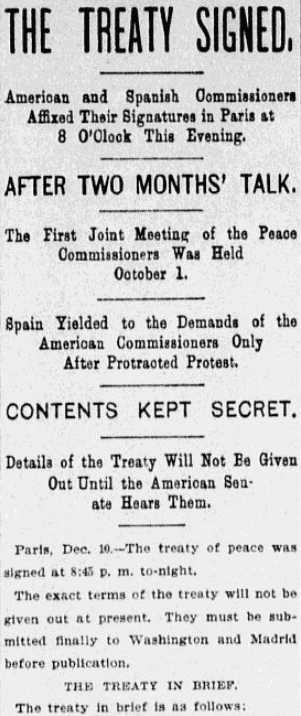After ten weeks of difficult negotiations, Spain and the United States finally signed the Treaty of Paris on 10 December 1898, officially ending the Spanish-American War. This 14-week conflict, described as “a splendid little war” by American ambassador (soon to be Secretary of State) John Hay in a letter to his friend (and war hero) Theodore Roosevelt, is perhaps America’s least known war, and certainly one of its most controversial.

Some historians say the Spanish-American War was an honorable affair, fought by altruistic Americans to free the oppressed Cubans from the yoke of Spanish colonization. Others say this was America’s foray into imperialism: its first war fought not to consolidate its holdings on the North American continent but rather to gain overseas possessions.
The American public had been whipped into a frenzy against Spain, especially after a massive explosion sank the U.S. battleship Maine in Havana Harbor, Cuba, killing over 260 men, on 15 February 1898.

With the public, newspapers, and business community all calling for action, a reluctant President William McKinley could not stem the war fervor. After Spain rejected an ultimatum to leave Cuba, Congress declared that a state of war with Spain had existed since 21 April 1898.
Fought from 25 April to 12 August 1898, with military engagements in Cuba, Puerto Rico, the Philippines, and Guam, American forces destroyed two Spanish fleets and beat several armies. Recognizing its defeat, Spain sued for peace and a cease-fire was declared on August 12. The American and Spanish commissions met in Paris on October 1 and talks began, with America clearly negotiating from a position of strength.
When the final treaty was settled, Spain agreed to withdraw from Cuba and ceded the Philippines, Puerto Rico and Guam to the United States for $20 million. Spain’s days as a world power with an empire were over, while America’s emergence as a world power was firmly established.

Here is a transcript of this article:
THE TREATY SIGNED.
American and Spanish Commissioners Affixed Their Signatures in Paris at 8 O’clock This Evening.
AFTER TWO MONTHS’ TALK.
The First Joint Meeting of the Peace Commissioners Was Held October 1.
Spain Yielded to the Demands of the American Commissioners Only after Protracted Protest.
CONTENTS KEPT SECRET.
Details of the Treaty Will Not Be Given Out until the American Senate Hears Them.
Paris, Dec. 10 – The treaty of peace was signed at 8:45 p.m. tonight. The exact terms of the treaty will not be given out at present. They must be submitted finally to Washington and Madrid before publication.
The Treaty in Brief
The treaty in brief is as follows.
First – The customary preface of treaties, in the nature of an expression of amity and of hope for perpetual peace.
Second – The relinquishment by Spain of her sovereignty over Cuba.
Third – The withdrawal of the Spanish troops.
Fourth – The relinquishment by Spain of her sovereignty over Porto Rico.
Fifth – Spain’s cession of the Philippines.
Sixth – The withdrawal of the Spanish troops there.
Seventh – Payment by the United States of 20 million dollars for the Philippines.
Eighth – The provision for the “open door” commercial policy in the Philippines.
The joint peace commission met at 3:30 this afternoon and at 5:15 took a recess until 7 p.m.
At the Afternoon Meeting
The Americans were the first to arrive at the foreign office, the Spaniards coming half an hour later. Senor Montero Rios, president of the Spanish commission, ascended the steps leaning on a cane and bundled up in a fur coat. The Americans shook hands with the Spaniards when the latter entered the conference hall.
The commissioners were photographed in a group, after which they listened to the reading of the treaty until 5:15, at which hour they took a recess until 7 o’clock.
Their Last Meeting
The adjournment was to allow the finishing of the engrossing of the treaties. This was not completed until late. When the commissioners met at 7 o’clock they listened to the reading of the remainder of the treaty. This took three-quarters of an hour and after its conclusion the treaty was signed.
…On the day that the Spanish commission was appointed the American commission sailed from New York to Liverpool, where it arrived September 24. Three days later both commissions reached Paris. The first business meeting was held October 1.
The evacuation of Cuba and the cession of Porto Rico were at once taken up. Spain insisted that the United States assume the Cuban debt. It was not until October 21, three weeks after the first meeting, that Spain yielded her first point and agreed to assume the debt.
The Philippines Question
Ten days later the United States commission took up the question of the Philippines. It was proposed that Spain cede the group to the United States and that the United States assume part of the debts of the islands. The Spanish commission refused practically to consider the proposition. They entered into long disputes over the wording of the protocol. Then they asked for time. November 21 the United States presented an ultimatum in which 20 million dollars was offered for the islands. The Spanish commissioners were shocked at the proposal and said, in interviews, that Spain might yield the islands to force, but she would never take money for them.
Wanted 100 Million Dollars
Three days later they suggested to the American commissioners that 100 million dollars might be considered. This offer was refused and they asked for delay. Finally, November 28, the American terms were agreed to.
Note: An online collection of newspapers, such as GenealogyBank’s Historical Newspaper Archives, is not only a great way to learn about the lives of your ancestors – the old newspaper articles also help you understand American history and the times your ancestors lived in, and the news they talked about and read in their local papers. Did any of your ancestors serve in the Spanish-American War? Please share your stories with us in the comments section.
Related Articles:
